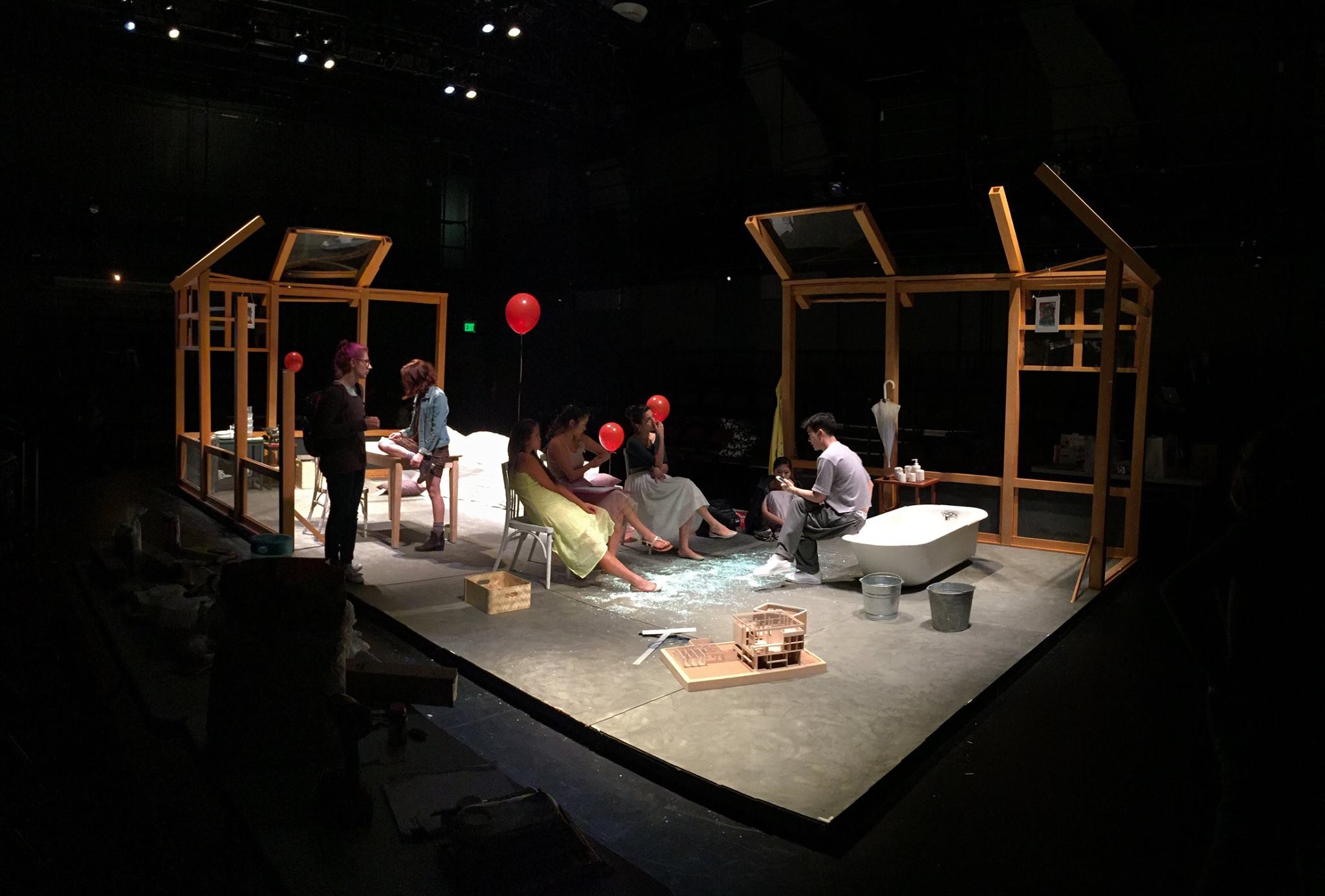by Janis Jin (Contributing Writer)
It’s a weekend for rain.
Stefani Kuo’s Architecture of Rain, the Yale Dramat’s first Fall Ex, opened on Thursday night to a nearly sold-out audience.
Directed by Gregory Ng, Architecture of Rain is a story about grief and loss set in a glass house made of memory. The play follows a family of four Asian women as they mourn the death of their youngest daughter, All-Grown-Up.
The four women who make up the play’s cast – Allison Du, Evan Billups, Arya Sundaram, and Emily Locke – laugh, sob, and hold each other in this glass house that always seems to break. Memories of All-Grown-Up are interrupted by a broken stove, a leak in the roof, things left unfixed. Detached wooden beams mark the unfinished nature of the house itself.
“These women inhabit the physical space of memory and forgetting, and see how it tugs and pulls at their dynamic, their family, their life,” Kuo describes.
Through fragmented memories brought back to life by a family desperately trying to hold onto their lost loved one, Architecture of Rain asks us to consider the “little griefs” that shape the experience of loss. The longing to remember the sound of someone’s voice, the silence and stillness that accompany an absence at the dinner table, and the inhabiting of spaces that surge with memories. What does it mean to remember – and re-remember – someone whom we can no longer hold?
But perhaps just as powerful as the content of the play is what Architecture of Rain means for the Yale theatre community in terms of racial representation. With a cast of four Asian actresses and a crew dedicated to centering their stories, everything about this play is a product of the love, labor, and life of Asian women at Yale.
The play’s author, Stefani Kuo, drew inspiration for Architecture of Rain in the summer of 2015 while working with the National Asian American Theatre Company. It was there that she saw, for the first time, an all-Asian cast in a production that wasn’t necessarily centered on their Asian identity.
Kuo didn’t begin writing Architecture of Rain with an all-Asian cast in mind. But when she met Asian American playwright Melisa Tien at the Yale Playwrights’ Festival in February, she saw what it could mean for her to be an Asian woman and a successful playwright in this country – and moreover, how powerful it could be to create spaces for Asian characters in theatre. Thus, Architecture of Rain, with a family of four Asian women, was born.
The thing about this production is that the play itself doesn’t focus on being Asian or Asian American. For director Gregory Ng, this is precisely the reason he was drawn to Stefani’s play.
“Architecture of Rain isn’t necessarily an Asian American story or an Asian play,” he explains , “but it is about a broader truth that is told through the reality of an Asian family. It is about accessing something real and powerful through a cast of Asian women telling a story that is not necessarily specific to their race. This project is about centering Asian women by saying that they, too, have the ability to speak to universal experiences.”
Though the story itself might not be about Asian identity, both Ng and Kuo say that the play very much draws from their own homes and experiences. “This play is very much borne out of me,” Kuo says, “and in that sense it is created out of an Asian American experience. I was raised in an Asian culture, with an Asian family.”
Ng grew up in Singapore, where he recalls sleeping close to the ground for most of his life. “I actually slept on a floor mattress most of the time,” he says. In envisioning what he wanted the house in Architecture of Rain to look like, he wanted to create an idea of home that drew from his own home – and thus, they constructed the family’s bed to be low and close to the floor.
As an artist who identifies as both queer and Asian, representation in theatre is at the forefront of everything that Ng creates. “As Asian people and people of color, we are expected to view white people’s experiences as universal, as if white people are the arbiter of emotion because their stories are supposedly ‘the most relatable,’” he notes. “But why is it that white people aren’t expected to relate to art made by people of color as capable of expressing some universal truth too? Why is that such a hard sell?”
Ng also believes that it is incredibly important to have white people in theatre who are committed to supporting work created by people of color – and Alexa Derman, the show’s producer, is perhaps a perfect example of that.
“I think working on this show as a white person has given me a tremendous opportunity to put into action ideals I hold,” she claims. “Saying that you want diverse theatre is meaningless when the only shows you help bring to life are your friends’ Shakespeare pieces. I try to only produce the theatre I feel needs to happen. This show is a perfect example of that. This is the exact play that makes it worth staying up late into the night looking into discount dance supplies: I know its existence is so vital. I am so glad to have been a small part in helping to support a gorgeous play helmed by brilliant people of color.”
For stage manager Maxine Dillon, being a part of the production has given her a sense of home here at Yale. As a woman of color who is half Asian, she says, “It is empowering and uplifting to see the work of the four Asian women who make up our cast – and to know that this is a world that they and I and we can all inhabit.”
This is the beauty of Architecture of Rain – every member of the team, from the cast to the crew, is committed to this play as a space that centers Asian women. Many of the women who originally auditioned for the four cast spots have been a part of the team by working on other aspects with the production team. Whether it was by spending hours painting and building the house that sets up the play’s spatial framework, or by helping with lighting and costume design, they too have been instrumental in helping this project come to life.
In Architecture of Rain’s glass house, the presence of absence is always felt. As memories fade in and out of each other, we are reminded how difficult it is to pinpoint the experience of losing a loved one; how grief is articulated in fragments of what has been lost, what remains, and what we long to hold onto. And as this family of four takes the stage, we know that there is so much love and power and beauty in portraying a universal experience through a play centered on a family of four Asian women.
Asian women of Yale – here’s to us.
Architecture of Rain runs Thursday Oct. 6 through Sunday Oct. 8 at the Iseman theater. You can buy tickets at http://dramat.org. Note from the crew: to make theatre more accessible to the Yale student body and the Greater New Haven community, we have released only half of the tickets for the Saturday night performance online. The remaining half will be available at the door on a pay-what-you-can basis.


